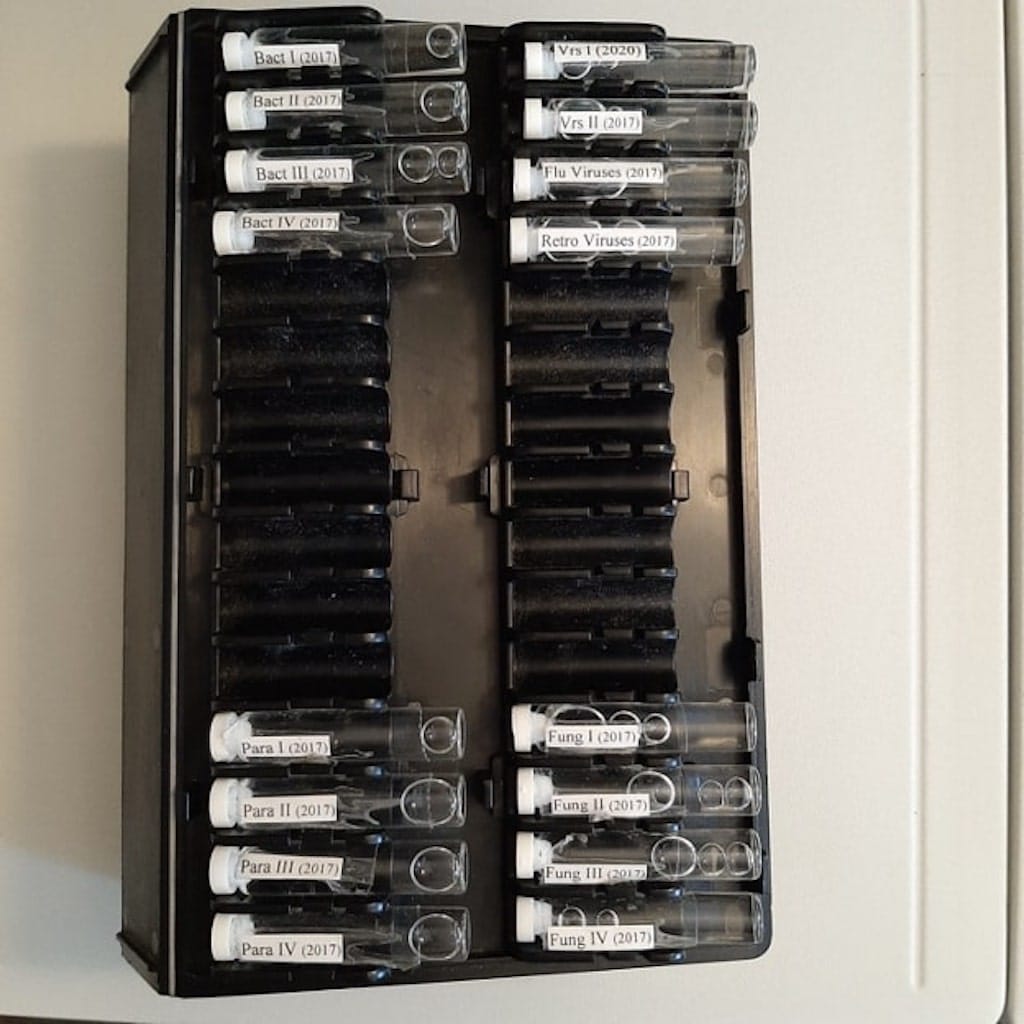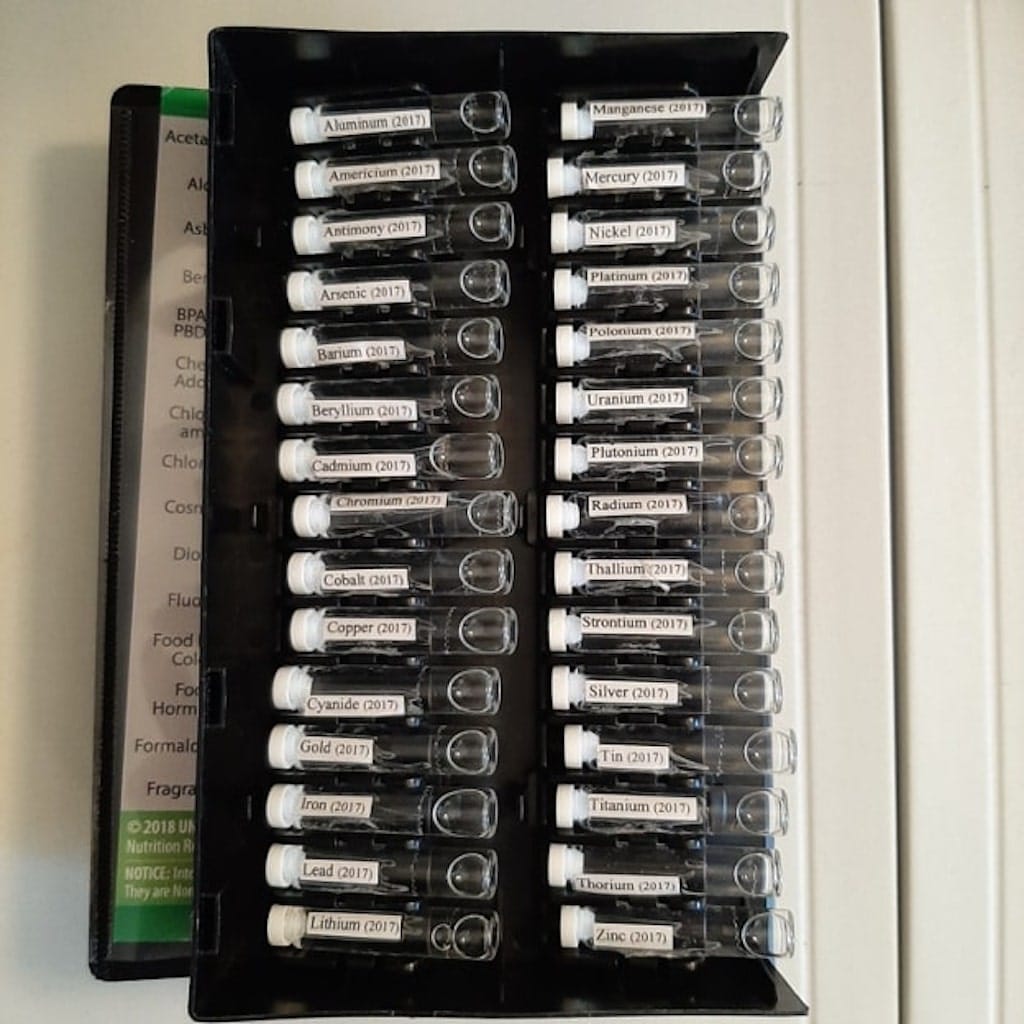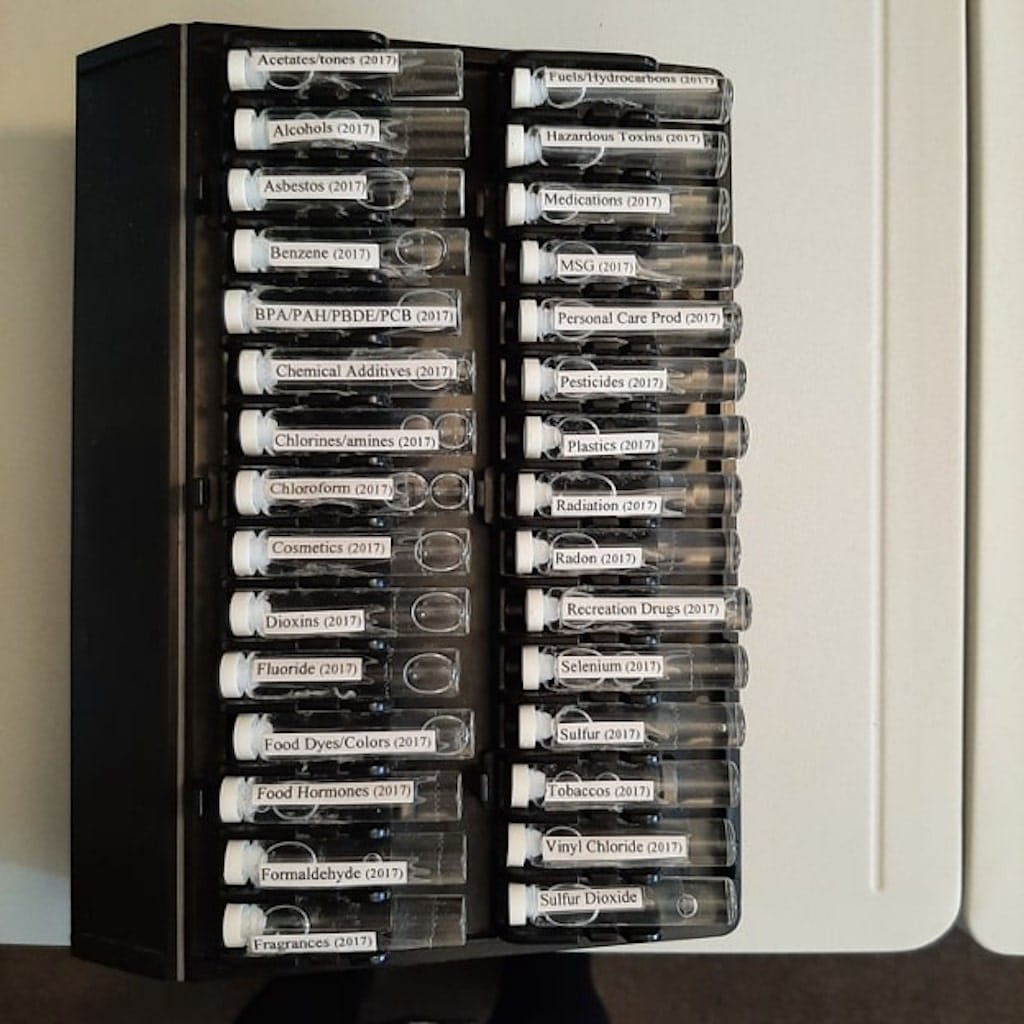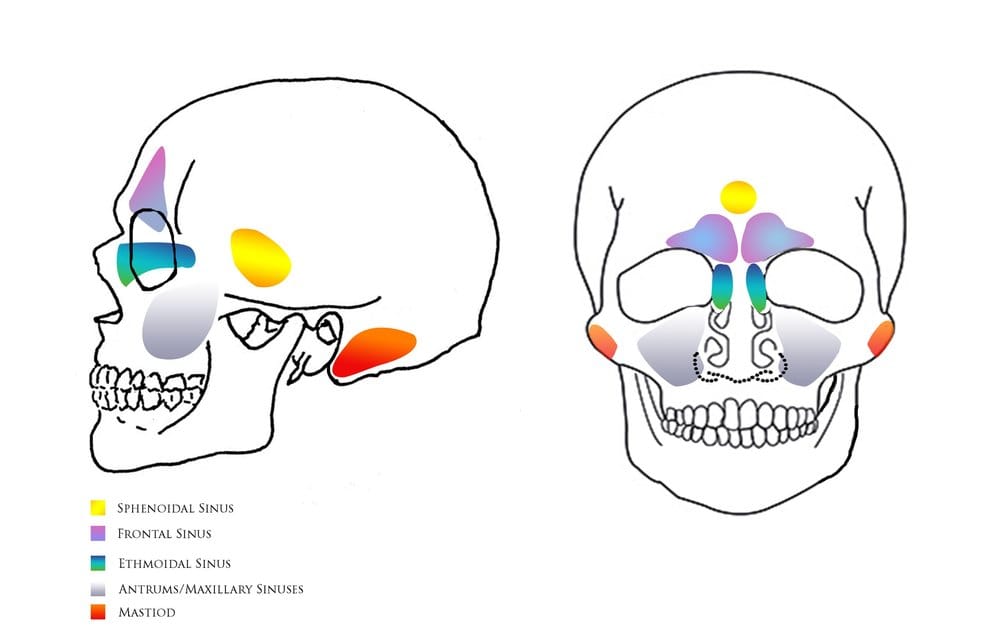Can Headaches and Migraines Really Be Cause By a Particular Organ
First, I want to discuss the various types of headaches and migraines before diving into how particular organs of the body can cause headaches and migraines.
Headache Types
At one time or another every human being has experienced a headache. These headaches can be throbbing and distracting. A headache can have various causes, different durations, and the pain severity can vary by the type of headache.
There are primary and secondary headaches.
Tension headache
Are typically triggered by stress. You may experience a dull, aching feeling all over your head. You may have soreness around your neck / shoulder muscles, forehead, and scalp.
Cluster headache
Someone with a cluster headache will experience a burning / piercing pain around or behind one eye. They can exist on one side of the face as well. Other common symptoms include swelling, redness, flushing with sweating on the side where headache is. There can also be nasal congestion and eye tearing on side the headache is on. Cluster headaches typically occur in a series. Individual headaches can last from 15 minutes to 3 hours and usually a person will experience one to four headaches in a day (usually around the same time.) Basically, as the headache resolves, another headache follows. Cluster headaches can occur daily for months, the rest of the time when a person is cluster headache free, no symptoms exist.
Migraine
This type of headache is the worse. There is pulsing pain deep within your head and can last for days, making it difficult to complete your daily routine tasks. This pain is throbbing and typically one-sided. Migraine sufferers can be sensitive to light and sound. Nausea and vomiting are usually experienced too. Migraine headaches can be preceded by a migraine aura (visual disturbances) causing a person to see flashing or shimmering lights, zigzag lines, stars or blind spots. A migraine aura can create tingling on one side of your face or arm, causing speaking problems. (Keep in mind strokes can causing these identical symptoms.
Common migraine triggers include sleep disruption, skipped meals, hormone fluctuations, dehydration, certain foods, and exposure to chemicals. Women tend to be more prone to migraine headaches.
Hemicrania continua
This headache is a moderate type on one side of your head that exists for at least 3 months. During the day one may feel increased intensity throughout the day. Hemicrania continua headaches are twice as common in women. This headache may be associated with tearing or eye redness, nasal congestion or runny nose, forehead sweating, miosis (excessive constriction of the pupil), eyelid drooping, and restlessness or agitation.
Ice pick headache
The name says it all. They are defined by brief, intense stabbing pains lasting a few seconds. They come on with no warning and can happen several times per day. Ice pick headaches can move to different parts of the head.
Thunderclap headache
Thunderclap headaches are extremely painful headaches which come on quickly in under a minute while reaching their highest intensity within that minute. A thunderclap headache may be caused by a serious condition such as blood vessel tears or blockages, a stroke, a brain injury, or vasculitis and should be checked out by a medical doctor.
Secondary headaches are a symptom of something else that is going on in your body. If the trigger of your secondary headache is ongoing, your headaches can become chronic. Treating the primary cause generally brings headache relief.
Allergy or sinus headache
These headaches can happen due to an allergy. Allergy or sinus headaches are located in your sinus areas.
Hormone headache
This headaches occurs in females due to hormone fluctuations around menstruation, birth control pills use, and pregnancy.
Caffeine headache
Caffeine changes the blood flow to your brain. If a patient stops drinking coffee “cold turkey” they run a risk of having a headache. If they have more caffeine than usual, they can get a headache. If a person has frequent migraines, they are at a higher risk of creating a headache from caffeine use.
Exertion headache
These types of headaches occur after intense physical activity such as running, sex, and weightlifting. These activities may increase blood flow to your skull causing throbbing headache on both sides of your head. They resolve within a few minutes or several hours.
Hypertension headache
These are headaches caused by high blood pressure and is a medical emergency because the blood pressure is extremely high. The headache will be on both sides of the head and usually worse with activity. Other symptoms to watch out for are changes in vision, nosebleed, shortness of breath, numbness or tingling, and chest pain.
Rebound headache
A rebound headache is due to taking acetaminophen, ibuprofen, aspirin, or naproxen more than 15 days in a month. They can feel like a tension headache or can be extremely painful (like a migraine.) They are more common in people who take medications containing caffeine.
Post-traumatic headache
Post-traumatic headaches can occur after head injury. They feel like tension or migraine headaches and can last up to 6-12 months after the initial injury and may become chronic.
Types of Migraine Headaches
Medically Reviewed by Hansa D. Bhargava, MD on November 09, 2020
MIGRAINE TYPES
Migraine sufferers typically feel a throbbing on one side of their head. The migraine can cause nausea, vomiting and sensitivity to light and sound. They are more severe than headaches.
With or Without Aura?
There are 2 types of migraines 1) migraine with aura (visual symptoms like lines, flashes, or shapes) and 2) migraine without aura. Some people can lose their vision for 10-30 minutes as well as experience tingling in your arms / legs. An aura can affect your taste, smell, touch, or speech. People who get an aura will notice it before the head pain begins and the aura may last for an hour. Here are some migraine subtypes.
Brainstem Aura Migraine
This can cause visual, sensory or speech / language problems. To be labeled a brainstem aura, the migraine needs to cause at least two of these symptoms: 1) slurred speech, 2) vertigo, 3) tinnitus, 4) double vision, 5) unsteadiness, or 6) severe sensitivity to sound.
Episodic Migraine
The most common pattern of migraine for most migraine sufferers. Basically, a person get migraines from time to time (up to 7 days out of the month.) If a person has migraines more than 7 days, they will be told they have high-frequency episodic migraines (migraines for 8-14 days per month) or chronic migraines (migraines for 15 or more days per month for 3 months or more.)
Hemiplegic Migraine
Hemiplegic means paralysis on one side of the body. There will be an aura that is companied by weakness on one side of the body for 72 hours or less. No nerve damage is caused but this type of migraine mimics a stroke and should be taken seriously at the first occurrence.
Migraine Without Headache (Silent Migraine)
The main sign of a Silent Migraine coming on is an aura. A person can experience nausea with it as well as other migraine system. These typically last 20 – 30 minutes.
Abdominal Migraine
The migraine is located in your belly rather than your head. Symptoms can be 1) stomach pain, 2) appetite loss, 3) nausea, and 4) vomiting.
Abdominal migraines affect children mostly who have typical migraines or family history of migraines.
Menstrual Migraine
Typically a menstrual migraine will start 2 days before a woman’s period and last for 3 days. Usually there is no association with an aura with a menstrual migraine. Patients with this type of migraine will experience migraines at other times of the month.
Ocular (or Retinal) Migraine
Ocular migraines are extremely rare. Patients will see colors, flashing lights, or other visual changes including partial loss or total loss of vision in one eye. The vision loss will usually last less than an hour, then be followed by a migraine.
Vestibular Migraine
With a vestibular migraine, a person gets vertigo which is a spinning sensation that can be short lived or last up to several hours.
Status Migrainosus
Is a migraine that lasts for more than 3 days. It’s pain and nausea may cause a person to be hospitalized. Certain medications or withdrawal from medications can cause this type of migraine.
Particular Organs That Cause Headaches and Migraines
Nutrition Consulting Syracuse Dr. Nanci Knox reports in today’s world, headaches and migraines have become very common. It is estimated that $78 Billion is spent annually on migraines in the United States. This $78 billion is spent on medications, office visits, emergency room visits, laboratory and diagnostic services, and management of treatment side effects (meaning the medications given have side effects.) In the United States 45 million people complain of headaches yearly. Another way of looking at that number is about one in every six people will have a headache or 16.54% of the population will have a headache. There is a study estimating the cost of medical care for Americans with migraines averages $6,575 per year! (If you have a 20% co-pay, you’re paying $1,315 per year.) What about missed workdays, especially if you only get paid if you do not work?!
I bet you did not know there are twenty-three organs that can be causing your headaches and migraines. I bet you are also saying no way, I do not believe it. Well believe it! Do you want to know what these organs are? Well, several are part of your endocrine system, digestive system, respiratory system, and urinary system. The twenty-three organs are:
- Frontal Lobe
- Cerebellum
- Pituitary
- Hypothalamus
- Liver
- Gall Bladder
- Small Intestines
- Large Intestines
- Pineal Gland
- Sinuses
- Tonsils
- Thyroid
- Bladder
- Uterus / Ovaries
- Testicles
- Vagina
- Parathyroid
- Lungs/Bronchi
- Heart
- Stomach
- Kidney
- Adrenals
As a Nutrition Consulting Syracuse doctor, I love helping people resolve their headaches and migraines without the use of medications. My worse case was a female patient who estimated she would be migraine free for 4 days out of 30. This just blew my mind. She had learned to function despite the migraines but was sick and tired of dealing with them. In six months, we flipped those numbers around, out of 30 days she would only have migraines for 4 days. This patient was elated!!
I know you are asking “What did you do for this patient?” As an Advanced Clinically Trained Nutrition Response Testing practitioner I used Nutrition Response Testing to determine what organ was causing her migraines. Nutrition Response Testing uses muscle testing to determine which organs including the various parts of the nervous system are creating the headaches and migraines. Once the organ(s) are identified, Dr. Knox digs even deeper to determine what is affecting the organ(s). There are 5 Common Stressors that can be affecting the organ(s) which in turn will be causing the headaches or migraines. The first stressor is immune challenges such as bacteria, viruses, mold, and parasites. Then there are food sensitivities, metals, chemicals, and scars. As a Nutrition Response Testing practitioner, we use electronically imprinted vials which have the energy frequency of the above mentioned 5 Common Stressors to see what is affecting the organ(s) via muscle testing. It is quite brilliant, fascinating to the patient and a whole lot of fun for the practitioner. Once the specific Common Stressors are determined, then Whole Food Supplements from Standard Process are muscle tested against the organ to find the best one for the job. These Whole Food Supplements give the organ the genuine replacement parts the organ needs to work optimally over next several months to alleviate the headaches or migraines.
Frontal Lobe
Headaches are more commonly caused by the frontal lobe than migraines are. These types of headaches are typically called tension headaches and are usually the result of stress. Frontal lobe headaches due to stress can be directly linked to the adrenal glands that handle stress and fatigue.
Frontal lobe headaches can also be caused due to infections, dehydration, poor posture, or computer screen eye strain. Frontal sinuses infection (these are located above each eyebrow) can cause headaches too. These cavities build up pressure due to inflammation from irritants, allergies, or infection leading to a headache.
This paragraph that follows holds true for all organs:
With Nutrition Response Testing, Dr. Knox will use muscle testing to do a complete body scan to see which organs cause a weak arm. Most people will have more than one organ go weak. Of all the organs that go weak it is crucial to determine which is of most urgency to be handled. (Your body is like an onion and each organ is a layer of the onion. If the outer layer is not handled first, you will be just chasing symptoms.) Once the most urgent organ is determined, the 5 Common Stressors will be used to verify if a Food Sensitivity, Immune Challenge, Metal, Chemical or scar is affecting the organ. If a Common Stressor is affecting the organ, the best whole food supplement will be found to start handling the Common Stressor immediately.
The best supplements for the frontal brain are Min-Chex, Min-Tran or Ribonucleic Acid (RNA).
Cerebellum
Nutrition Consulting Syracuse Dr. Nanci Knox reports migraine patients having their cerebellum be the cause of headaches and migraines. Research is starting to show the Purkinje cells found in the cerebellum to possibly be the cause especially for inherited migraines.
These are the supplements Dr. Knox may use for cerebellum malfunction causing headaches and migraines: Ribonucleic Acid (RNA), Min-Tran, Super EF, Neurotrophin PMG, and Neuroplex.
Pituitary
The pituitary gland is referred to as the Master Gland due to the fact it produces a number of hormones to control other glands like the thyroid gland and adrenal glands. The pituitary gland is about the size of a pea and resides behind the bridge of your nose. The pituitary gland has an anterior lobe and a posterior lobe. It is attached to the bottom of the hypothalamus. This adds another puzzle piece to the cause of headaches and migraines due to the endocrine system not functioning properly.
Common supplements Dr. Knox uses for headaches and migraines caused by the pituitary gland are: Pituitrophin PMG, E-Manganese, Symplex F or M and Paraplex.
Hypothalamus Caused Headaches or Migraines
The hypothalamus has 2 important roles. It controls the autonomic nervous system and the function of the endocrine system. Therefore, it has a huge role in all the essential life processes. The hypothalamus communicates with the pituitary gland causing it to release endocrine hormones based on the hormones released by the hypothalamus. The hypothalamus could be thought of as the command center controlling all the other the endocrine organs. If the hypothalamus is malfunctioning, it can be the indirect cause of headaches or migraines due to affecting an endocrine organ further down the line. A pituitary gland tumor can also be a cause of headaches and migraines.
The best whole food supplements for the hypothalamus are Hypothalamus PMG, Hypothalamex, Neurotrophin PMG, o Nueroplex.
Pineal Gland
A pineal gland cyst can cause especially migraines. This happens by apoplexy which is bleeding into the pineal gland. If the cyst is larger then 5mm it should be picked up on a MRI. This type of migraine is common in women between 20 and 30 years of age.
Pineal gland tumor can be a cause of headaches and migraines. The tumor can be cancerous or non-cancerous. Surgery is usually required.
The 5 Common Stressors used with Nutrition Response Testing can reveal some interesting things. Dr. Knox may find an immune challenge, metal, or chemicals affecting the pineal gland cyst or tumor.
Supplements of choice are: Niacinamide B6, Ribonucleic Acid
Sinuses
Sinuses are hollow spaces in your head. You have the maxillary sinuses behind your cheekbones, frontal sinuses above each eyebrow, ethmoid sinuses along the sides of your nose, mastoid sinuses behind your ears, and the sphenoidal sinus in the middle of your forehead. They make your head lighter while producing mucus to trap harmful particles (dust, pollutants and bacteria) as air flows through your sinuses to your lungs.
Sinus headaches are so common and are caused by infections of the various sinuses. The most common causes of sinus infections are the common cold, seasonal allergies, nasal polyps and a deviated septum not allowing mucus to drain out of the sinuses. When too much mucus is developed it give germs quite the advantage to grow. As these germs increase their colonies, they exasperate the sinuses causing them to swell and block the passage of mucus. This build up of mucus makes your face tender and achy. Some people will feel pressure in their sinuses and on their teeth.
Dr. Knox has found in a number of patients there is liver involvement. This is because the liver has gotten plugged like an oil filter will get plugged. As the liver becomes plugged it starts to look for other natural channels to get rid of toxins and the sinuses are its number one choice. A number of her sinus patients need both sinus and liver support, plus a change of diet. The diet change helps to decrease the number of toxins being dumped into the body while decreasing the toxic load on the liver.
Her favorite supplements for the sinuses are: Allerplex, Antronex, Fen Gre, Cataplex AC, Cataplex ACP, Epimmune, and Liverplex.
Tonsils
Tonsillitis and peritonsillar abscess can both cause headaches. A virus or bacteria infection can cause tonsillitis, leading to sore throat and headaches. A peritonsillar abscess can form in the space behind the tonsils due to tonsillitis complication. The abscess can produce headache, difficulty swallowing and swollen lymph nodes.
Supplement support for the tonsils: Cataplex AC, Cataplex ACP, Epimune, Antronex, and Spanish Black Radish.
Thyroid Caused Headaches or Migraines
If a person has a under active thyroid (known as a hypothyroid) this can be the cause of their headaches or mirgraines. An under active thyroid causes a decrease in hormones that impact your metabolism and blood pressure. Therefore the root cause may be not giving the body the necessary nutrients to keep metabolism and blood pressure under control, which than leads to headaches or migraines.
The last thing to do for the thyroid is start feeding it the proper whole food supplement to give it the nutrients it has not be receiving to restore it to it’s full functional state. The best supplements for this are: Thytrophin PMG, Oragnically Bound Minerals, Calcium Lactate and Essential Fatty Acids (SuperEFF, Cod Liver Oil, Tuna Omega 3 Oil, Linum B6, Cataplex F Perles, and Black Currant Seed Oil).
Parathyroid
Hyperparathyroidism is when there is too much calcium in the blood and the amount of extra calcium can be slight or a lot. It is actually the duration of high calcium levels that causes the symptoms of hyperparathyroidism of which recurrent headaches are one. Other symptoms are chronic fatigue, body aches, difficulty sleeping, bone pain, memory loss, poor concentration, and depression.
Most common supplements used: Cal-Ma Plus, Cataplex D, Cataplex F perles or tablets.
Lungs/Bronchi
COPD can cause headaches upon waking in the morning. In a person without COPD, oxygen will go down into the lungs and out the walls of your lungs. A person with COPD can have portions of the lungs that are clogged or have been destroyed. In COPD patient it becomes difficult to inhale oxygen and exhale carbon dioxide. This person’s blood will not contain enough oxygen. This is the definition of hypoxia. Therefore the COPD person’s heart will be overworked and hamper tissue functions. COPD patients will have too much carbon dioxide in their blood. This all leads to headaches upon waking because of the increased amount of carbon dioxide in the blood during your sleep.
Pulmonary migraines can have symptoms of recurrent asthma, cough producing mucus from the lungs, low back pain radiating to the shoulders, collapse of part or all of the lung and occasionally nausea with vomiting. It is hypothesized that spastic bronchi narrowing causes the migraine.
Lung supplements that could be used are: Pneumotrophin PMG, Allerplex, Antronex, Fen-Gre, Cataplex AC, Epimune, and Cataplex ACP.
Heart
- Some patients can experience a headache or migraine along with heart palpitations. There are lifestyle factors that can produce headache with heart palpitations. They are stress, alcohol, caffeine and other stimulants, tobacco use and exposure to smoke, some medications and dehydration.
- High blood pressure can also cause headaches and migraines.
- Anemia can cause heart palpitations with headache or migraine. Anemia is when the body lacks healthy red blood cells. Red blood cells carry oxygen to the various parts and organs of the body. A person may feel tired or weak, may look pale, have cold hands and feet, feel dizzy, and/or have shortness of breath.
- Hyperthyroidism can affect your heartbeat.
- Panic attacks may influence your heartbeat.
- Pheochromocytoma is a tumor affecting the adrenal glands and the tumor releases hormones causing headaches or migraine with heart palpitations. Other symptoms may be high blood pressure, tremors and breath shortness.
Heart supplements Dr. Knox uses are: Cardio-Plus, Cataplex E2, Cataplex G, Cataplex C, Cardiotrophin PMG, Calcium Lactate, Magenesium Lactate, Vasculin, Cataplex E, Cataplex B, Cataplex ACP, Cyruta Plus, Cyruta, and Essential Fatty Acids (SuperEFF, Cod Liver Oil, Tuna Omega 3 Oil, Linum B6, Cataplex F Perles, and Black Currant Seed Oil).
Stomach, Small Intestines, and Large Intestines
Research has shown that people who regularly experience gastrointestinal symptoms, such as reflux, diarrhea, constipation and nausea — have a higher prevalence of headaches than do those who don’t have gastrointestinal symptoms. Studies on irritable bowel syndrome and celiac disease is starting to link migraines to these digestive health issues.
As a Nutrition Consulting Syracuse doctor, Dr. Knox has studied the Second Brain which is located in the Gastrointestinal tract. Your gastrointestinal tract has its own microbiome consisting of 1) essential / beneficial flora, 2) opportunistic flora, and 3) transitional flora.
- The essential / beneficial flora is the most important and most abundant in a healthy person. It can be considered indigenous friendly bacteria consisting of Bifidobacteria, Lactobacteria, and Propionobacteria. It also contains physiologicial strains of E. coli, Peprostreptococci, and Enterococci.
- The opportunistic flora is a large group of various microbes. Their number and combinations can be quite individual. In healthy individuals these numbers are normally limited and are closely regulated by the beneficial flora. Opportunistic microbes cause various health problems when they get out control.
- Transitional flora are various microbes that we daily swallow with food and beverage. If the gut is well protected by essential / beneficial flora, these microbes goes through our digestive tract doing no harm. Whereas, if the essential / beneficial flora is damaged and not able to protect well, transitional microbes can cause disease.
One can now see the importance whether for headaches or migraines or for other health issues, the gastrointestinal tract needs to be cleaned up as well as heal and seal the gut (as the saying goes.) This then stops the major source of toxicity in the body, allowing the entire digestive tract to be a source of nourishment.
Most Americans do not realize our digestive system, skin, eyes, respiratory and excretory organs are coexisting with TRILLIONS of invisible lodgers. This allows an ecosystem of macro-life and micro-life to live together in harmony. This is a symbiotic relationship in which one cannot live without the other.
Our digestive tract contains the largest amounts of microbes. These microbes are a highly orchestrated micro-world with certain microbes predominating and controlling others. The functions of these microbes are vital to us. In fact, it is said that if our gut was sterilized we would die.
The entire gastrointestinal tract has a bacterial layer known as the “Gut Wall” which provides a natural barrier against invaders (undigested food, toxins, and parasites.) This is what happens to unprotected soil when the turf has eroded. (Turf is the upper layer of soil bound by grass and plant roots into a thick mat.) Once the gut wall suffers, its protective “turf” gets damages.
Besides forming a physical barrier, the essential / beneficial flora acts a security guard by keeping invasive pathogenic micro-organisms in check. The opportunistic flora produces antibiotic-like substances, anti-fungal volatiles, anti-viral substances (interferon, lizocym and surfactins) to dissolve the membranes of viruses and bacteria. They make the immune system respond appropriately to the invaders. The beneficial bacteria will create an acidic environment to hinder the growth and activity of the bad bugs needing an alkaline environment, preventing the bad bugs from taking over.
These bad bugs produce a ton of very potent toxins. Keep in mind this is on top of all the toxic substances we take in with food and drink. The cell walls of the digestive tract’s good bacteria absorb many cancer-causing substances to make them inactive. The good bacterial cell walls blot out hyperplastic processes leading to cancer formation.
The ”Walls of the City” become unprotected when the essential / beneficial bacteria in the digestive tract are damaged, thus not working as they should. This is why we have so many people with headaches, migraines and other health issues. Without a healthy gut wall the body becomes open to invasion from viruses, fungus, bacteria, parasites, and toxic items. These bad bugs can damage the digestive tract by causing chronic inflammation in the gut wall. Do not forget about the opportunistic flora living in the digestive tract waiting to take over the essential / beneficial flora in the gastrointestinal system if the timing becomes right.
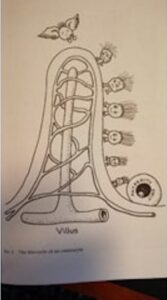
The intestines have an absorptive surface containing villi. Villi are finger-like protrusions with deep pits between them. The enterocytes coating the villi are the epithelial cells that do the digesting and absorb the nutrients from the food in the small intestines. The epithelial cells work extremely hard, therefore they must be young and in great shape to work effectively. God made a wonderful way to ensure the “Walls of the City” stay healthy. In the deep pits, enterocytes are continually being created. Once created, the enterocytes slowly journey up to the top of the villi as they do their job of digestion and absorption while maturing. Once the enterocytes reach the villi top, they are released allowing the “Walls of the City” to be continuously rejuvenated with new enterocytes so the “Walls of the City” always work properly.
Animal research with sterilization of the gut (when the essential / beneficial flora bacteria is removed) has proved the process of enterocytes renewal gets totally out of order. The journey from the deep pits to the villi top takes longer leading to the upset of the enterocytes maturation process and frequently turns them cancerous. The cell division in these deep pits 1) become significantly less, 2) the enterocytes created will be less healthy, 3) therefore making it difficult to do their job well. This all leading to abnormal enterocytes because the housekeeper (essential / beneficial flora bacteria) are not there to take care of them.
In our bodies, the lack of good bacteria ALWAYS coincides with bad bacteria getting out of control. This makes the situation even worse. Without the good bacteria fighting to keep control, the bad bacteria attacks and wins over our bodies. This changes the structure of the “Walls of the City,” causing pathology and disease to creep into our bodies. The body’s villi start 1) to degenerate, 2) are unable to digest and absorb nutrients correctly, and 3) this leads to malabsorption, nutritional deficiencies, and food sensitivities.
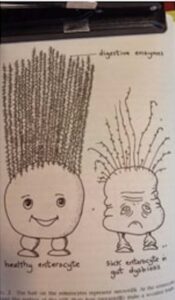
Dr. Natasha McBride (founder of the GAPS Diet) sums it up so well from her GAPS Diet book (page :
A well-functioning gut with healthy gut flora hold the roots of our health. And, just as a tree with sick roots is not going to thrive, the rest of the body cannot thrive without a well-functioning digestive system.
The bacterial population of the gut – the gut flora – is the soil around these roots, giving them their habitat, protection, support and nourishment.
Research is showing those regularly experiencing gastrointestinal symptom like reflux, diarrhea, constipation and nausea are more likely to have headaches than those without gastrointestinal symptoms.
There are many whole food supplements Dr. Knox tests against the stomach, small and large intestines: Multizyme, Zypan, Betaine HCL, Enzycore, Gastrex, Okra Pepsin E3, Chlorophyll Perles, Dermantrophin PMG, Cataplex G, Lactic Acid Yeast, Lact Enz, Prebiotic Inulin, ProSynbiotic, Spanish Black Radish, Fen Cho, Choline, Cholacol, Whole Food Fiber, Disodium Phosphate, SP Purif Program, and Cataplex AC.
Liver
Nutrition Consulting Syracuse Dr. Nanci Knox has helped unplug patients livers to eliminate their headaches and migraines. Livers become clogged just like an oil filter. Toxins have a difficult time leaving the body and over time cause various health issues.

Common things I see improve when liver problems are addressed:
- Headaches / Migraines
- Blood Pressure
- Rashes
- Arthritis
- Weight
- Reflux
- Chronic Fatigue
- PMS
- Coated Tongue
- Constipation
- IBS
- Gall Bladder Problems
- Bloating
- Depression
- Sugar Cravings
- Mood Changes
- Brain Fog
- Allergies
- Bad Breath
- Excessive Sweating
- Offensive Body Odor
- Dark Circles Under Eyes
There are 3 things the affect the liver: 1) The Standard American Diet (SAD), 2) our environment, and 3) chemicals.
The Standard American Diet (SAD)
The following list contains poor food choices, chemicals used in food, and food cooking sources.
Foods
Processed Foods
Non-Organic Foods
Fast Foods
Vegetable Oils
Sugar
Grains (White Stuff)
Corn Syrup
High Fructose Corn Syrup
Chemicals
Herbicides
Pesticides
Fungicides
Glyphosate
MSG
NutraSweet
Other Artificial Sweeteners
Cooking Sources
Microwave
Our Environment
Air Pollution – Both inside and outside of your home and place of employment
Petrochemiclas – From industry and cars
Water Contaminats – Acid Rain, Toxic Runoff from farms and factories
Cleaning Supplies – Currently this is increase due to COVID19
Chemicals
- Medications
- Synthetic Supplements
- Makeup
- Sunscreen
- Plastic
- Bug Repellant
- Bromine in Clothes
- House Cleaning Product
- Sanitizers
- Vaccines
- Personal Care Products
- New Car Smells
- Shower / Bath Water
- Scented Candles
- Air Fresheners
- Perfumes / Cologne
- Chlorine
- Formaldehyde
Your liver has 3 detox pathways:
Phase 1 – Cytochrome P450 Enzymes
Phase 2 – Conjugation Pathway and
Phase 3 – Transportation
Phase 1 – Cytochrome P450 Enzymes
1-First line of defense against toxins.
2-Cytochrome p450 enzymes convert toxins into smaller substances while making them water soluble for Phase 2.
3-This phase is about oxidation of toxins into smaller substances while creating free radicals which can cause harm if they cannot move through the next 2 phases and out of your body.
Phase I is activated by many external toxins:
Caffeine
Alcohol
Dioxins
Paint Fumes Steroids
Pesticides
Sleeping Pills
Birth Control
Cortisone
Phase 2 – Conjugation Pathway
1-Phase 2 needs sulfur, certain amino acids, molybdenum (trace mineral), vitamin B12, and Glutathione. This is where the Standard American Diet (SAD) gets the liver into trouble. (This can explain insomnia, brain fog, or hot flashes.)
2-Uses 6 different pathways to get the smaller water-soluble toxic substances from phase 1 out of your body though your bile, urine, and stool.
Phase 3 – Transportation
1-The phase 2 conjugates get transported for further filtration before leaving your body.
2-They leave your body either through your bladder / urine or your bile into your small intestine then through the large intestines and out with your stool.
3-Adequate hydration is necessary for proper bladder/ urine elimination.
4-Healthy daily bowel movements are needed (This means no constipation, sluggishness, loose stools or diarrhea.)
As the liver functioning starts to improve, it is quite common for patients to have to see their medical doctor. This is because their blood pressure is getting too low or they are noticing they are bruising easily. Both are indicators they need less blood pressure medication because the liver is not getting as clogged with toxins.
If you find yourself constantly waking up between 1am and 3am, you are having liver problems.
Foods You Can Eat to Support Your Liver
Beets
Beet Kvass
Avocados
Cruciferous Vegetables
Green Leafy Vegetables
Lemons
Fatty Fish
Berries
Garlic
Nuts
Extra Virgin Olive Oil
Eggs
Organ Meat (especially liver)
Headaches and migraines can be caused by the liver due to being plugged up like and oil filter. Toxins in our bodies create various health issues, some minor like high blood pressure to major like cancer.
The whole food supplements recommended are: Hepatrophin PMG, Betacol, Livaplex, AF Betafood, Choline, Cholacol, Fen Cho, Garlic, Spanish Black Radish, Phosfood, Cataplex B Core and Cataplex B.
Gall Bladder
The gall bladder in conjunction with the liver are meant to clear toxins from the body. When they are functioning properly there is stress and a dis-stress signal is passed along a meridian. Meridians are non-visual energetic pathways running through the body. The human body has 12 regular meridians which are thought to correspond to an organ. They start from different areas of the brain and spread out to various parts of the hands and feet.
If the gall bladder and / or liver is stressed, these organs’ meridians run through the neck up to the temples and through the optic nerve causing tightness in the neck muscles. This can cause temple headaches, headaches in back of the eyes, or headaches in the back of the head, over the head and in back of the eyes. Have you ever rubbed your temples, forehead, eyes or back of your head? Rubbing these areas create temporary relief because you are rubbing the involved meridians containing acupressure points.
Gall Bladder support would be AF Betafood, Betafood, Choline, Phosfood, and Cholacol.
Bladder
Yes, the bladder can cause headaches and / or migraines. 1) A Urinary Tract Infection (UTI) can cause headaches. The bacteria E. Coli can be found in the bowel and near the anus. Typical symptoms most people are familiar with are pain, mild fever, urinary urgency and frequency but an Urinary Tract Infection can also create headaches. 2) Migraines can exist with an Overactive Bladder (OAB).
Whole Food Supplements Dr. Knox uses with her patients have disfunctional bladders are: Albaplex, Arginex, Renafood, Renatrophin PMG, and AC Carbamide.
Uterus and Ovaries
Hormones have a key part in our mental and physical well-being. The sudden spike or reduction in hormones can cause significant jolt to one’s health. Here is why women can get headaches and / or migraines around their period. 1) The quantity of progesterone and estrogen in the female body can cause hormonal headaches. These headaches may occur before, during, or after one’s period. 2) If hormonal alterations occur during the period, serotonin and various brain neurotransmitters can be affected causing mild to moderate to severe migraines. 3) Some women have heavy period flow which can cause anemia and iron deficiency brain fog because they are loosing so much blood. Their blood lacks the necessary oxygen to nourish their brain and body, so there are women who experience migraines which may be more painful and longer lasting than other migraines. 4) Fibroids can be the root cause of heavy period flow leading to anemia which is the cause of migraines or headaches.
Dr. Knox recommends these Whole Food Supplements for headaches caused by the uterus: Urotrophin PMG, Symplex F, Calcium Lactate, Cataplex F Perles, Cyruta Plus, Wheat Germ Oil, Cataplex D, For-Til B12, Orchic PMG, Orchex, and Essential Fatty Acid Supplements like SuperEFF, Cod Liver Oil, Calamari Oil, Linum B6, Black Currant Seed Oil, and Hemp Oil Complex.
Testicles
Orchitis (inflammation of the testicle) can be a cause of headaches in a male. This inflammation is caused by either a viral or bacterial infection. One or both testicles can be infected and a male can have a rapid or gradual increase in symptoms of pain and swelling.
Testicular choriocarcinoma is a malignant tumor and is considered a non-seminomatous germ cell tumor (NSGCT). It is the rarest form of testicular cancer. It can be classified as 1) a pure choriocarcinoma or 2) a component of a mixed germ cell tumor. The pure choriocarcinoma is very aggressive, metastasizes early and is widespread. It likes to metastasize to the skin, digestive tract and the brain. Males can experience headaches or migraines when it has metastasizes to the brain.
With headaches and migraines caused by the testicles Dr. Knox recommends Orchic PMG, Ochex and Symplex M (once testicular choriocarcinoma has been ruled out.)
Vagina
Vaginal yeast infections can cause headaches and migraines. Women may also experience itching or burning, have extreme swelling leading to vaginal rashes. The infection is sometimes called vaginal candidiasis and are created by a fungus. Some women will have discharge that can be either 1) watery or 2) thick, white, and odorless (resembling cottage cheese.)
Side Note-Men can get yeast infections too when having sex with a female having a vaginal yeast infection. This occurrence is more likely in uncircumcised men. Symptoms are 1) itching, burning or redness on the penis, 2) thick, white substance in the penis folds and moistness, and 3) shiny, white spots on the penis.
Bacterial vaginosis occurs when the healthy bacteria balance of the vagina is off. Symptoms are 1) burning upon urination, 2) fishy smell that is stronger after sex, 3) itching, and 4) thin white, gray, or green discharge. (Vaginal yeast infection will have a thick white discharge that does not smell.) Lactobacillus keeps the vagina properly acidic, making the vagina an unpresent home for bad bacteria to make home!
Female Whole Supplement recommendations: Utrophin PMG, Dermatrophin PMG, and Lactic Acid Yeast.
Male Whole Supplement recommendations: Orchic PMG, Orchex, Symplex M, Dermatrophin PMG, and Lactic Acid Yeast.
Kidneys
Nutrition Consulting Syracuse Dr. Nanci Knox has found headaches / migraines will occur due to the accumulation of waste products in a person with kidney failure. A secondary cause of headaches /migraines caused by the kidneys are related to toxic absorption from inflamed kidneys. These toxics are not able to be filtered out of the blood and lead to kidney inflammation. Blood supplies nutrients but also contains toxins which need to be removed from the blood. If these toxins cannot leave the body, the body will try various elimination channels. These elimination channels are 1) your skin and can cause rashes, 2) sinuses causing congestion, headaches / migraines, 3) large intestine (this is why is so important to have 1 to 3 bowel movements per day), and 4) the liver but it can get backed up and lead to more health issues, especially high blood pressure which can also cause headaches / migraines.
These headaches / migraines may occur anywhere in the head. They can be in the front or back of the head. They can be one sided and therefore would be considered a migraine. These will be preceded by nausea and vomiting.
The whole supplements Dr. Knox will muscle test a patient for would be: Albaplex, Arginex, Renafood, Renatrophin PMG, AC Carbamide, Cataplex ACP, Phosfood, Choline and Niacinamide B6.
Adrenal Glands
The adrenal glands handle stress and fatigue. They are about the size of a walnut and sit on top of each of your kidneys. Unfortunately in today’s world, our adrenals are contently under stress due to workloads, people’s after work hour schedule (taking kids to extracurricular activities), poor eating habits, decreased sleep due to previous mentioned reasons, etc. In the past, people lives were much calmer and the adrenals were not being worked overtime. As humans when we are stressed, the adrenals glands release the hormone Cortisol. This Cortisol will effect the body in various ways: 1) increase heart rate, 2) raise blood sugar levels (think diabetes), 3) cause weight gain, and 4) trigger headaches / migraines by interacting with the body’s nervous system.
Here are the whole food supplements Dr. Knox finds most helpful with headaches /migraines caused by the adrenal glands: Drenatrophin PMG, B6 Niacinamide, Adrenal Desiccated, and Drenamin.

